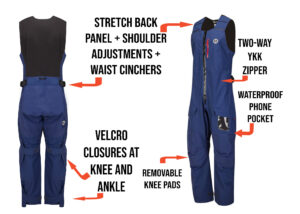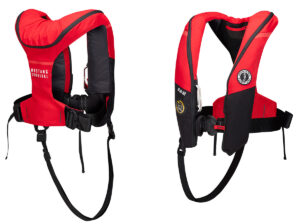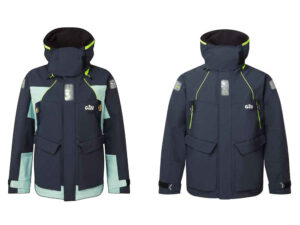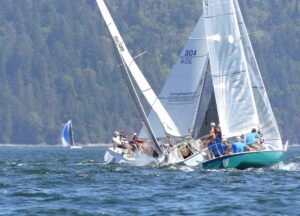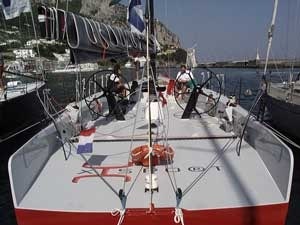
As the tactician crosses the boat during a tack, he grabs a small display panel stuck to a cockpit bulkhead with Velcro. Once settled on the rail, he starts pressing buttons on the display and in a few moments has retrieved SOG, current push, time to layline, windspeed and direction, and depth. Armed with that information, he tells the skipper where to aim the boat and on the next tack, slaps the display back on the bulkhead, set on target speed. There’s a sensor at the top of the rig beaming down instantaneous wind readings to cockpit and mast displays as well as the nav station. These displays, solar-powered and sprouting nary a wire, have the capability to show users any data they could possibly want to pull up. The nav station has no writhing mass of wiring behind it, and adding or removing instruments is a snap. As the boat is racing, the team’s coach boat is downloading race data to a laptop computer for an after-race chalk talk.
Is it far-fetched fantasy? Nope, were talking here and now. With advances in wireless technology driven by worldwide market demand, racers can either equip their boat with a complete wireless system or upgrade existing instrument systems for wireless data retrieval and display. Wireless technology will allow racers to shave weight all over the boat. There may even be cost savings in boat construction, as boatbuilders will no longer have to spend precious time leading wires.
Leading the way in wireless raceboat electronics is Tacktick, an English company thats been selling solar-powered race instruments to small keelboat and dinghy sailors since 1996. For the past three years Clive and Mark Johnson, the managing directors and founders of Tacktick, have been developing their wireless Micronet system for marine use. Tacktick has seven years of experience using solar powered instrumentation-backed up with lithium batteries-so they already had the power issue worked out when they began thinking about the Micronet system three years ago. Theyve since developed their own communication protocol, which is similar to the most commonly used wireless protocols-Bluetooth and 802.11b (see box)-but uses less power and takes up a smaller amount of bandwidth. “Our bandwidth is secret but allows you to have faster data transmission than any other system on the market,” says Clive. “Its very quick and very able to transmit what were doing and gives us plenty of room for expansion.”
A typical Micronet package on a 40-foot boat might be set up like this: Speed and depth transducers, which are through-hull fittings, are mounted near a fluxgate compass transducer down low in the hull. Those three sensors are wired (yes, but its only a short little wire) to a hull transmitter (powered by the boats batteries but equipped with a backup, 300-hour lithium battery), which will send their data to both the cockpit and nav station displays and a NMEA interface. On deck, a GPS receiver sends data through another short wire to the NMEA interface, which can be mounted anywhere on the boat. Up the rig, a wind transmitter, powered by solar cells, sends data to the system below [Clive says that the Micronet system has a range of about 120 feet]. Displays, also powered by solar cells, can show any of the data on the network. A laptop sits in the nav station talking to all the instruments mentioned above and to Micronets Information On Deck tablet that shows all the information from the laptop below, including charting software, tactical data, and the pictures from your latest vacation. All up, this package (sans laptop) would cost you around $5,000. Base systems (speed and depth) start at $1,015.
Tacktick is also working on a MOB system for Micronet in which every crewmember wears a small, lozenge-shaped unit that will automatically activate an alarm and an MOB button on the GPS should the wearer go in the drink. All the display heads will automatically begin displaying range and bearing to the MOB as well. The Tacktick distributor for the United States is Layline Yacht Racing Equipment, www.layline.com.
|
|
| |
|
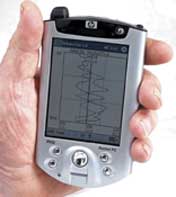
|
| |
| Courtesy Ockam|
| |
|
|
| |
| Ockam’s Eye system allows tacticians to retrieve data from the instrument system, including strip charts* * *|
| |
|
|
| If you prefer the B&G; or Ockam systems, theres wireless news from these companies, too. Ockam has introduced their Eye system. If you have an Ockam system thats computer-interfaced, you can go wireless with off-the-shelf products available at any Radio Shack or CompUSA-a Windows CE-equipped pocket PC (Eye will not work with Palm software) and a generic 802.11b transmitter. Ockams Eye software is loaded on the boats computer and a pocket PC, the 802.11b transmitter is hooked up to or installed in the laptop, and youre off and running, your hard-hiking tactician clutching a pocket PC and retrieving any data you need for racing, including strip charts (graphic displays of trends).
Most people who have installed wireless computer networks at home will have an easy time setting up Ockams system, but for those who have difficulties programming their VCRs, you can send your pocket PC, transmitter, and laptop to Ockam and theyll set it up for a fee. Ockam, estimates a price of around $475 for the software package. www.ockam.com
B&G; USA is also getting into wireless technology for raceboats, and recently introduced a wireless PC tablet for on-deck use. The tablet uses Bluetooth protocol with some proprietary code written by B&G.; It’s sold with Deckman software, and uses an off-the-shelf transmitter. The entire package, including the PC tablet, software, and all, will cost somewhere around $11,500.
“It’s a high-end system made for the racing market,” says Rob Law, president of B&G; USA. “We’ve discussed other wireless applications quite a bit over the last year, and wireless is definitely on the list for us. The issue, especially for masthead sensors, is getting power to the unit without running a wire up the mast.”
A soon-to-be-released remote control for autopilots by B&G; may be of interest to boat owners looking to spend a little less for wireless equipment. It will communicate with infrared (as do many laptops), and will have the ability to display instrument data such as windspeed, depth, and apparent wind angle. www.bngusa.com
A company thats been using pocket PCs and Personal Digital Assistants (PDAs) with great success is MapTech, which offers a program called Pocket Navigator. Installed on a GPS card-equipped PDA, Pocket Navigator allows you to track your boats progress on Maptech digital charts. Its not tactical software but its a quick and easy way to get important navigational data live in the cockpit of a smaller boat. A waterproof housing for the PDA is a good investment. Software packages for specific PDAs start at $349. Charts are extra. www.maptech.com
The one obvious disadvantage of wireless communications is that signals can be intercepted. Fortunately, the security issue is a huge concern in the world of business, and software solutions that involve signal scrambling and password protection are readily available. On the Tacktick side, Clive Johnson says that each system has its own identity number and that the odds of two boats having the same number are very small. If it did happen, the displays on both boats would display digital gibberish until the boats moved apart.

